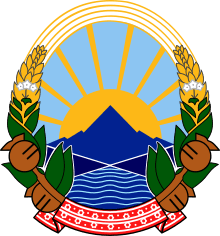Elections in North Macedonia
North Macedonia elects on national level a head of state - the president - and a legislature. The president is elected for a five-year term by the people. The Assembly of the Republic of North Macedonia (Sobranie) has 120-123 members, elected for a four-year term, by proportional representation. North Macedonia has a multi-party system, with numerous parties in which no one party often has a chance of gaining power alone, and parties must work with each other to form coalition governments.
 |
|---|
| This article is part of a series on the politics and government of North Macedonia |
|
Legislature
|
|
|
|
Last elections
Presidential elections were held in May, 2019.
Parliamentary
The Parliamentary election took place on 27 April 2014. The incumbent ruling party, Christian-democratic nationalist party VMRO-DPMNE, got 42.98% of the votes and won 61 of the 123 seats in the Sobranie. The Social Democratic Union, SDSM, won 25.34% of the votes and 34 seats, and the DUI, which is the largest Albanian party, won 13.71% of the votes and 19 seats.[1]
Presidential
On 21 April, the first round of the presidential elections resulted in the incumbent president Gordana Siljanovska Dafkova receiving 42% of the votes. She did not receive the support of 50% of all registered voters, and so a second round was held together with the parliamentary elections on 5 May. In this round, Stevo Pendarovski won 42.84% of the votes and the main contestant for the post, Gordana Siljanovska Dafkova, won 42.24%.
Ethnic groups
Following Macedonian independence in 1991, politics in the country are split along ethnic lines with Albanians voting for Albanian parties and Macedonians voting for Macedonian parties.[2] In this context elections have come to reflect the censuses.[2] Ethnic groups in the country view a change in the demographic composition of an administrative unit of government as resulting in a change of a mayor's ethnic affiliation that would implement the choices and priorities of their community.[2]
References
- "4471". Utrinski.mk. Archived from the original on 2014-04-30. Retrieved 2014-04-30.
- Ragaru, Nadege (2008). "The Political Uses and Social Lives of "National Heroes": Controversies over Skanderbeg's Statue in Skopje". Südosteuropa. 56 (4): 537.CS1 maint: ref=harv (link)